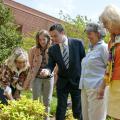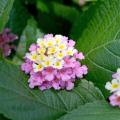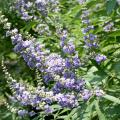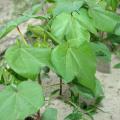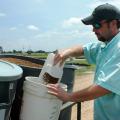News From 2010
MISSISSIPPI STATE – Mississippi State University is offering two deer management workshops in late July and August to hunters, land managers and foresters working with white-tailed deer populations.
Register by July 9 for the first course, offered July 24 from 9 a.m. to 4:30 p.m. at the Forrest County Extension Office in Hattiesburg. Register by Aug. 13 for the second course, offered Aug. 28 from 9 a.m. to 4:30 p.m. at Thompson Hall on the campus of MSU. The $50 fee for the course covers lunch and educational materials.
MISSISSIPPI STATE – Mississippi’s young cotton crop has already faced a list of challenges including flooding, late planting, insects and now drought.
“It’s been a challenge from the word go,” said Darrin Dodds, cotton specialist with the Mississippi State University Extension Service. “We went from an almost perfect planting season last year to one that seems to have continually fought us this year.”
By Karen Templeton
MSU Ag Communications
MISSISSIPPI STATE -- The Mississippi Entomological Museum is poised to identify destructive invaders -- taking the form of seemingly harmless bugs -- sneaking into the country and threatening significant damage to U.S. agriculture.
By Patti Drapala
MSU Ag Communications
OXFORD – Mississippi State University and the University of Mississippi have teamed up to make Oxford and the surrounding community an even more beautiful place through an educational partnership.
Mississippi Master Gardeners is an educational exchange program offered through the county offices of MSU’s Extension Service. Individuals who have an interest in plants and gardening sign up for the program, go through basic training, and receive certification in horticulture and its related areas.
STONEVILLE -- Football great D.D. Lewis will be the keynote speaker at the July 15 Agronomic Crops Field Day at Mississippi State University’s Delta Research and Extension Center.
A former Dallas Cowboy linebacker, Lewis was an All-American and Southeastern Conference Player of the Year in 1967 at Mississippi State and was inducted into the College Football Hall of Fame in 2001.
If you’re looking for a way to keep your flowerbeds pretty after your pansies have worn out, consider using lantanas as your transition. They will provide fantastic color through the hottest temperatures.
Lantana has been selected twice as a Mississippi Medallion winner. The very first medallion plant in 1996 was New Gold lantana, and its bright, golden-yellow flowers are outstanding. The second Medallion win came in 2003 to Sonset lantana, whose flowers start as yellow and transition through orange, red, magenta and purple.
BAY ST. LOUIS – An upcoming conference will offer tips on how rural communities can increase their tourism and thrive during these challenging economic times.
The fifth annual Regional Tourism Summit of the Miss-Lou Rural Tourism Association can help community leaders, small business owners and tourism professionals identify local opportunities and design creative marketing plans to bring visitors to small, rural areas.
MISSISSIPPI STATE -- After three years of depressed timber markets, prices are increasing because of strong demand for forest products and low inventories of logs following the year’s wettest months.
David Jones, assistant forest products professor with the Mississippi State University Extension Service, said the first half of 2010 showed a marked increase in demand for a number of forest products and price increases in most timber product categories.
By Patti Drapala
MSU Ag Communications
FRANKLIN, Tenn. – Although she looks for symptoms and clues when examining her animal patients, Mississippi State University veterinary alumna Paula Ann Schuerer never suspected the real reason when a former instructor called with questions.
The MSU College of Veterinary Medicine was considering Schuerer as its 2010 Alumnus of the Year. The college’s feline specialist, Dr. Sharon Grace, needed to complete the nomination about Schuerer and her veterinary practice in Franklin, Tenn., a town on the outskirts of Nashville.
By Patti Drapala
MSU Ag Communications
COLUMBUS – The Culinary Arts Institute at Mississippi University for Women kicked its cuisine up another notch after partnering with Mississippi State University to restore the program’s overcrowded herb garden.
The garden still features many common herbs, such as sage, oregano and thyme, but it now includes several varieties of each one. In the works are plans to add fruit trees and other plants that will broaden students’ knowledge of the preparation and presentation of food.
The Chastetree has begun flowering, and its brilliant blooms are causing many to stop and take notice.
The native range of Chastetree is the low woodlands of southern Europe and western Asia. It was first introduced to the United States by settlers in the 1500s. Known botanically as Vitex agnus-castus, the name dates back to ancient Greece, when Athenian woman lined their beds with the leaves during the feast of Ceres. It also known as chasteberry and monks pepper.
MISSISSIPPI STATE – An army of scientists and experts are closely monitoring the Gulf of Mexico oil leak and local conditions to ensure that seafood being sold in Mississippi is safe for consumers.
Dave Burrage, a marine resources specialist with the Mississippi State University Extension Service in Biloxi, said the Mississippi Department of Marine Resources and the Mississippi Health Department are guarding the safety of seafood being caught and sold.
MISSISSIPPI STATE -- Spring rains have been kind to most Mississippi farmers, and conditions are offering cotton one of its best starts in recent years.
Darrin Dodds, cotton specialist with the Mississippi State University Extension Service, said most of the state’s crop has been slightly ahead of schedule.
“The weather has not caused a significant amount of replanting, but there are always exceptions, and if you are one of those farmers, it is significant,” Dodds said. “We also have had some fields needing replanting because of herbicide damage.”
MISSISSIPPI STATE – A high-performance bermudagrass developed at Mississippi State University may soon appear on golf courses and sports fields in the Far East because of a licensing agreement between the university and a prominent company in Japan.
The agreement allows Zoysian, Inc. Japan Branch to sell and market Choice, a bermudagrass developed by MSU researchers Wayne Philley and Jeff Krans of the Mississippi Agricultural and Forestry Experiment Station.
MISSISSIPPI STATE – A fish longer than 7 feet, heavier than 200 pounds and able to survive outside the water for up to two hours sounds like a fictional animal. This fish is the alligator gar, however, and researchers at Mississippi State University are working to protect it.
The population of the alligator gar is in decline, primarily due to loss of spawning habitat and over-fishing by anglers. Scientists and graduate students in MSU’s College of Forest Resources are hoping to reverse this trend.
MISSISSIPPI STATE — A forest management specialist at Mississippi State University has been named Extension Forester of the Year by the Forest Landowners Association.
Stephen Dicke, Extension professor in MSU’s College of Forest Resources, will receive the honor at the organization’s annual meeting in Stevenson, Wash.
By Patti Drapala
MSU Ag Communications
CORINTH – As a child, Alma Hopper was too shy even to say “please pass the peas” at the family dinner table, but a lifelong journey in 4-H helped her find her voice as an advocate for youth.
Hopper is an adult volunteer leader in Alcorn County’s 4-H program. She serves as a resource person for all of the county’s 4-H clubs. Many club members and leaders speak of her enthusiasm and dedication to the 4-H creed of “making the best better.”
Verbenas are great flowering plants that have been garden staples for many years. They will provide you with three seasons of color if you provide a few necessities for them.
There are more than 250 species of verbenas with many native to the New World. Breeders have been hard at work, and most new selections bear little resemblance to their forbears.
STONEVILLE -- The state’s catfish industry -- battling high feed costs, low prices and foreign competition -- is seeing many acres come out of production as producers fight to remain profitable.
In 2009, 15,000 acres of ponds went out of catfish production, and more are expected to leave production this year. Mississippi continues to lead the nation in catfish production and acreage, but the state’s current 65,000 acres is 43 percent short of its peak of 113,000 acres in 2002.
As spring turns into summer, gardeners start looking at flowering plants that take the heat while putting on a good floral display. Annual vinca is always a good choice.
Annual vinca’s foliage is a dark, glossy green with a prominent rib in the middle of the leaf. This dark background really sets the stage for showing off the white, pink, purple and red flowers.
Annual vinca is available in both upright and spreading growth habits. Various series have been studied extensively in the Mississippi State University trials at Crystal Springs and Poplarville.
Pages
News Types
- Crop Report (418)
- Feature Story (5850)
- Feature Photo (53)
- Extension Outdoors (318)
- Southern Gardening (1436)
- Extension Inbox (95)
Archive
- 2024 (138)
- 2023 (182)
- 2022 (187)
- 2021 (177)
- 2020 (212)
- 2019 (223)
- 2018 (276)
- 2017 (338)
- 2016 (383)
- 2015 (457)
- 2014 (498)
- 2013 (490)
- 2012 (492)
- 2011 (356)
- 2010 (323)
- 2009 (313)
- 2008 (273)
- 2007 (263)
- 2006 (252)
- 2005 (278)
- 2004 (273)
- 2003 (279)
- 2002 (228)
- 2001 (238)
- 2000 (243)
- 1999 (233)
- 1998 (232)
- 1997 (239)
- 1996 (58)
- 1995 (36)



